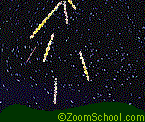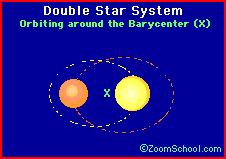
 |
| You might also like: | The Constellations | Today's featured page: Drawing and Adding Fractions, Printable Worksheets |
| Table of Contents | Enchanted Learning All About Astronomy |
Site Index |
| Our Solar System | Stars | Glossary | Printables, Worksheets, and Activities | ||||||
| The Sun | The Planets | The Moon | Asteroids | Kuiper Belt | Comets | Meteors | Astronomers | ||
| A | B | C | D | E | F | G | H | I | J | K | L | M | N | O | P | Q | R | S | T | U | V | W | X | Y | Z |
DARK ADAPTATION Dark adaptation consists of the physical and chemical changes in your eyes that allow them to see well in the dark. Physically, the pupils of the eyes open wider (this happens quickly); chemically, slower changes occur in the eyes (which takes 10-20 minutes). It takes about 20 minutes for your eyes to completely adapt to darkness. Once your eyes become accustomed to the dark, even a momentary flash of white light can ruin it and your eyes will have to adapt all over again. |
DARK-LINE SPECTRUM A dark-line spectrum (also called a absorption spectrum) consists of dark absorption lines superimposed on a bright continuous spectrum. An absorption spectrum is created when light from an incandescent source passes through a cooler gas that absorbs photons. Each different element and molecule absorbs light at a unique set of frequencies. Astronomers can determine the composition of gases in stars by looking for characteristic frequencies (this is called spectroscopy). |
DARK MATTER Dark matter is unknown matter that may constitute as much as 99 percent of the matter in the universe. |
D'ARREST, H.L. Heinrich Louis d'Arrest (1822-1875) was a Danish astronomer and the co-discoverer of Neptune (in 1846), with Galle. |
DAY A day is the length of time that it takes a planet to rotate on its axis (360°). A day on Earth takes almost 24 hours. |
DEATH STAR THEORY The Death Star Theory refers to the fact that mass extinctions are periodic, and may be caused by the Earth's passing through a cloud of comets (the Oort cloud) every 26 million years. Some people have hypothesized that there is a yet-to-be-discovered dark star or perhaps a planet (called, appropriately enough, Nemesis) orbiting in the outer reaches of our solar system. This body disrupts the Oort cloud (once every 26 million years), sending comets into the inner parts of the solar system, some of which hit Earth and cause mass extinctions. |
DECAYING ORBIT A decaying orbit is one in which the orbiting object is slowly spiraling towards the primary. The radius of the orbit is decreasing over time. For example, when one of the Earth's satellites is in a decaying orbit, it enters the Earth's atmosphere and burns up as it falls towards Earth. |
DECLINATION Declination is a celestial coordinate that is used to measure the degrees of latitude above or below the celestial equator on the celestial sphere. |
DEEP SPACE 1 Deep Space 1 (DS1) was a NASA mission that was launched on October 24, 1998. DS1 tested 12 new advanced technologies in deep space, including ion propulsion, solar arrays, a deep space transponder, autonomous navigation systems, a miniature integrated camera spectrometer, etc. DS1's primary mission ended in September 1999. |
DEEP SPACE NETWORK NASA's Deep Space Network (DSN) is an international network of antennas that communicate with spacecraft and perform radio astronomy and radar astronomy observations. |
DEFERENT The deferent is the large circular orbit around which a planet was thought to orbit, in one or many epicycles. Epicycles are circular orbits within orbits that were used to (incorrectly) describe the orbits of objects in the Ptolemaic system (about A.D. 150). Epicycles and deferents were used to predict orbits until Kepler discovered the elliptical nature of orbits (early in the 1600's). |
DEIMOS Deimos (meaning "terror") is the smaller of the two tiny moons of Mars. Deimos is only 7.8 miles (12.6 km) across and has a mass of 1.80x1015. It orbits at a mean distance of 14,300 miles (23,000 km) from Mars. Deimos may be a captured asteroid. It was discovered by A. Hall in 1877. |
 DELTA AQUARID METEOR SHOWER The Delta Aquarids are a meteor shower that occur each year from July 14-Aug.18, with a maximum on July 28-29. This meteor shower occurs each year as the Earth passes through the orbit of an unknown comet, and icy debris from the comet burns up as it enters the Earth's atmosphere. The meteors in this shower seem to emanate from the constellation Aquarius, (but they do not). |
DENEB Deneb (which means "tail" in Arabic) is the brightest star in the constellation called Cygnus (the swan); Deneb is also referred to as alpha Cygni, and is the tail of the swan. This young, bright, white supergiant star is perhaps 1,500 light years away. Deneb is about 60,000 times more luminous than the sun! It is a white super giant star. |
DENSITY Density is a measure of how massive an object is per unit volume. For example, iron is more dense than wood; one cubic meter of iron weighs more than one cubic meter of wood. |
DESPINA Despina is a tiny moon of Neptune. It was discovered using NASA's Voyager 2 mission in 1989. It orbits 52,530 km from the center of Neptune and is about 148 km in diameter. |
DIAMETER The diameter is the longest distance from one side of a circle (or a sphere) to the other. |
 DIAMOND RING The "Diamond Ring" is a large burst of light that appears a few seconds before and after totality during a solar eclipse. The "Diamond Ring" is caused by the last bit of sunlight shining through valleys on the edge of the moon. |
DIFFRACTION Diffraction is the ability of a wave to bend around corners. The diffraction of light established its wave nature. |
DIFFUSE NEBULA A diffuse nebula is a wide, spread-out, irregularly-shaped cloud of gas (mostly hydrogen gas) in space that can be up to 100 light-years wide. This type of nebula can appear to be light or dark. |
DINOSAUR Dinosaurs were land-dwelling reptiles that walked with an erect stance during the Mesozoic Era. Their unique hip structure caused their legs to stick out from under their bodies, and not sprawl out from the side (like other reptiles). They are extinct, but they evolved into the birds. The word dinosaur (meaning "fearfully great lizard") was coined by Sir Richard Owen in 1841. The first dinosaur in space was Maiasaura peeblesorum (a duck-billed dinosaur). A piece of bone from a baby Maiasaura and a Maiasaura eggshell were taken into space by astronaut Loren Acton on an 8-day NASA mission (Spacelab 2) in 1985. The historic Maiasaura fossils now reside at the Museum of the Rockies in Bozeman, Montana, USA. |
DIONE Dione is one of the 18 moons of Saturn. It has a diameter of about 600 miles (1,120 km). It orbits at a mean distance of about 235,000 miles from Saturn, revolving around the planet in about 65.75 hours. It has an icy surface with craters, plains and streaks of bright material. Some craters over 100 km wide. Its density is 1.43 gm/cm3, the densest moon of Saturn, indicating a large rocky core. Dione was discovered by G. Cassini in 1684. |
DIRTY SNOWBALL Comets are sometimes described as dirty snowballs. |
DOCKING Docking is when two spacecraft join together in space. |
DOGS IN SPACE Between 1958 and 1961, the USSR (now Russia) sent 13 dogs into space in preparation for future missions. Laika (meaning "barker" in Russian) was the first dog in space; she was launched in Sputnik 2 on November 3, 1957. |
DOPPLER SHIFT The Doppler shift (or Doppler Effect) is an increase or decrease in wavelength as the object emitting the wave moves relative to the observer. For example, a train whistle seems to be higher in pitch when the train is approaching you (the waves are compressed, shortening the wavelength), and lower in pitch when it is traveling away from you (the waves are elongated, lengthening the wavelength). The same thing happens with light waves when the light source is coming or going relative to us. For example, when a star is travelling away from Earth, its light appears redder (the light waves are elongated, lengthening the wavelength); this is called the red shift. The expansion of the universe was discovered when E. Hubble observed that the light from almost all other galaxies was red-shifted. The Doppler effect was named for Johann Christian Doppler (November 29, 1803-March 17, 1853), who first realized that it existed (1842). |
DORSUM A dorsum is a ridge on a planet's surface. |
 DOUBLE STAR A double star is two stars that appear close to one another in the sky. Some are true binaries (two stars that revolve around one another); others just appear together from the Earth because they are both in the same line-of-sight. |
DRACO Draco (from the dragon in Greek mythology) is a constellation in the Northern Hemisphere. It is the radiant of the Quadrantids and Draconids (meteor showers). Draco is near the northern celestial pole; the tail of Draco is between the Big Dipper and the Little Dipper. The brightest star in the Draco is Thuban; it is located in the dragon's tail. (Thuban means "dragon or serpent" in Arabic. Thuban was the Earth's pole star about 5,000 years ago.) The second-brightest star in the Draco is Rastaban (which means "head of the dragon or serpent"). |
N=R*fs*fp*ne*fl*fi*fc*L DRAKE EQUATION The Drake equation is a formula for estimating the possible number of intelligent civilizations in our galaxy. Most of the terms in this equations are unknown. In the equation, N is the number of civilizations, R is the average rate of star formation in the galaxy (about 20 stars per year ), fs is the fraction of stars that are suitable (about 0.1), fp is the fraction of stars with planets (about 0.5), ne is the mean number of planets that are located in a "habitable zone," where water exists in liquid form, fl is the fraction of these planets on which any life form evolves, fi is the fraction of places where some the life becomes intelligent, fc is the is the fraction of intelligent species who could communicate with us, and L is the lifetime (in years) of a civilization (this is quite uncertain). The equation was formulated by radio astronomer Frank Drake in 1961. |
DRAKE, FRANK Frank Drake (1930-) is a American radio astronomer who, in 1961, formulated an equation for estimating the possible number of intelligent civilizations in our galaxy (the Drake equation). |
DRAPER, HENRY Draper, Henry (1837-1882) was an American astronomer. He was also an early astronomical photographer. In September, 1880, Draper took the first photograph (a daguerreotype, which was a precursor of the modern photograph) of a distant astronomical object (the Orion Nebula). He also studied stellar spectra and was the first person to photograph stellar spectral lines. The Henry Draper system of star identification,the HD system of stellar classification, was named for Draper. His father, John William Draper (1811-1882), who was a chemist, took the first photographs (using a five-inch reflector telescope) of the moon in 1839-1840. |
(HENRY) DRAPER CATALOG The Henry Draper catalog is a catalog of stars in which every star is classified by its stellar spectrum. This sytem is named for the astronomer Henry Draper, but was cataloged by Annie J. Cannon (225,300 stars), and later extended by Margaret W. Mayall. For example, the star Vega is HD 172167 (the spectral type is not in the HD number). |
DUST Interstellar dust is composed of microscopic bits (on the order of a micron in diameter) of carbon and/or silicates. The origin of interstellar dust in unknown, but it seems to be associated with young stars. Interstellar dust is not at all like the dust we have in our houses (which is mostly bits of organic debris and lint). |
DUST LANE A dust lane is lane of dark interstellar dust in a galaxy or emission nebula. Dust lanes obscure light. |
DWARF PLANET A dwarf planet is an object that orbits a sun, has enough mass to give it a nearly round shape, is not a satellite of another object, and has not "cleared the neighbourhood" of its own orbit. This definition was established on Aug. 2006 by the International Astronomical Union (IAU) on August 24, 2006. Pluto is considered to be a dwarf planet because objects in the Kuiper Belt are within its orbit. Ceres (the asteroid) is also classified as a dwarf planet. Another dwarf planets is Eris (formerly called Xena); Eris has a moon called Dysnomia. There are many others. |
DWARF STAR Dwarf stars are relatively small stars, up to 20 times larger than our sun and up to 20,000 times brighter. Our sun is a dwarf star. |
| A | B | C | D | E | F | G | H | I | J | K | L | M | N | O | P | Q | R | S | T | U | V | W | X | Y | Z |
Enchanted Learning®
Over 35,000 Web Pages
Sample Pages for Prospective Subscribers, or click below
|
Overview of Site What's New Enchanted Learning Home Monthly Activity Calendar Books to Print Site Index K-3 Crafts K-3 Themes Little Explorers Picture dictionary PreK/K Activities Rebus Rhymes Stories Writing Cloze Activities Essay Topics Newspaper Writing Activities Parts of Speech Fiction The Test of Time
|
Biology Animal Printouts Biology Label Printouts Biomes Birds Butterflies Dinosaurs Food Chain Human Anatomy Mammals Plants Rainforests Sharks Whales Physical Sciences: K-12 Astronomy The Earth Geology Hurricanes Landforms Oceans Tsunami Volcano |
Languages Dutch French German Italian Japanese (Romaji) Portuguese Spanish Swedish Geography/History Explorers Flags Geography Inventors US History Other Topics Art and Artists Calendars College Finder Crafts Graphic Organizers Label Me! Printouts Math Music Word Wheels |
Click to read our Privacy Policy
| Search the Enchanted Learning website for: |